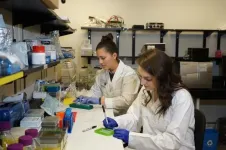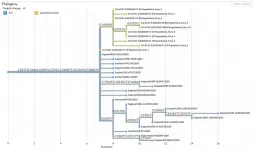(Press-News.org) New research demonstrates that African and Asian leopards are more genetically differentiated from one another than polar bears and brown bears. Indeed, leopards are so different that they ought to be treated as two separate species, according to a team of researchers, among them, scientists from the University of Copenhagen. This new knowledge has important implications for better conserving this big and beautiful, yet widely endangered cat.
No one has any doubts about polar bears and brown bears being distinct species. Leopards, on the other hand, are considered one and the same, a single species, whether of African or Asian origin. But perhaps that shouldn't be the case. In a surprising new research result, to which the University of Copenhagen has contributed, it has been made clear that the intercontinental cat cousins are more genetically different than the two species of bear.
"If one sticks with the traditional concept of speciation, the genetic difference is so great that African and Asian leopards shouldn't belong to the same species at all. As leopards are known to roam far and wide, we had expected to come across a much greater mix of genes among them. So, the result came as a surprise," says postdoc and study co-author Rasmus W. Havmøller of the University of Copenhagen's Natural History Museum of Denmark.
The genomes of 26 leopards were mapped by the researchers and account for eight of nine living leopard subspecies. Some of the genetic material used for the study was sourced from leopards in the Natural History Museum's collection. The findings have just been published in the journal Current Biology.
Current subspeciation doesn't hold water
Genome analysis indicates that current differentiations in leopard subspecies just don't hold water. While nine leopard subspecies have been officially identified, the study shows that in example Indian and Sri Lankan leopards are so closely related that they could be considered as a unified evolutionary significant unit.
According to Rasmus W. Havmøller, subspeciation is a central concept when it comes to the conservation of the iconic but endangered feline, whose overall distribution has shrunk by 75% - and locally, by as much as 98% - over the past 250 years.
"When planning leopard conservation efforts, one orients around different subspecies, which might each have their own conservation status. Therefore, this new knowledge can be useful if we are to develop better conservation strategies for leopards. I hope that these results spur debate about the role of genomics in subspeciation," says Rasmus W. Havmøller.
He adds that the results can hopefully be used as a tool to determine which animals are able to be intermixed across geographic regions, so as to maintain high genetic diversity, and whether leopard populations can be merged, as is frequently discussed:
"The answer must now be a resounding no when it comes to African and Asian populations. There is a risk of reducing genetic diversity when crossing a leopard that specialises in living in hot deserts, for example, with another that has adapted to frigid mountain conditions. You are likely to create offspring that are not well adapted to either habitat. On the other hand, our results demonstrate that there might be a solid foundation for interbreeding some of the more genetically similar Asian subspecies."
Emigrated from Africa in one go
Throughout history, leopards have dispersed over a vast area, from Siberia to South Africa. The new research also sheds light on when leopards spread from the African continent, their original home. Here too, the new results surprise - indicating that leopard migration from Africa occurred in a single 'dispersal event' some 500-600,000 years ago. Since then, there has been virtually no contact between leopards on the two continents.
"Until now, it was thought that the colonization of Asia by leopards occurred in several waves and not at once, as our results suggest. The timeframe accords with the concentration of ice at the poles, which precipitated low water levels between Africa and the Arabian Peninsula. This is what made it possible for leopards to cross the sea," explains Rasmus W. Havmøller.
The next step is to find out how the substantial genetic differences in African and Asian leopards are expressed - something that the current body of study does not reveal.
Rasmus W. Havmøller's cautious guess is that the differences are mainly expressed in characteristics linked to how leopards adapt locally.
INFORMATION:
FACTS:
The study was conducted by an international research team led by researchers at the University of Potsdam. Rasmus W. Havmøller and Eline Lorenzen from the University of Copenhagen participated.
The research article is published in the journal Current Biology.
The researchers conducted full-genome sequencing of samples from 26 leopards. The samples are collected from around the world and consist partly of fresh tissue and blood samples and partly of bone samples from museum specimens.
Over the past 250 years, the global distribution of leopards has shrunk by 75 percent. All living subspecies are classified by the IUCN as either critically endangered, endangered or vulnerable.
AURORA, Colo. (May 10, 2021) - Looking to safely block a gene linked to factors known to cause heart disease, scientists at the University of Colorado Anschutz Medical Campus may have found a new tool - light.
The study, published Monday in the journal Trends in Molecular Medicine, may solve a medical dilemma that has baffled scientists for years.
The gene, ANGPTL4, regulates fatty lipids in plasma. Scientists have found that people with lower levels of it also have reduced triglycerides and lipids, meaning less risk for cardiovascular disease.
But blocking the gene using antibodies triggered dangerous inflammation in mice. Complicating things further, the gene can also be beneficial in reducing the risk of myocardial ...
Hamilton, ON (May 10, 2021) - It is well known that each person's gut bacteria is vital for digestion and overall health, but when does that gut microbiome start?
New research led by scientists from McMaster University and Charité - Universitätsmedizin Berlin in Germany has found it happens during and after birth, and not before.
McMaster researchers Deborah Sloboda and Katherine Kennedy examined prenatal stool (meconium) samples collected from 20 babies during breech Cesarean delivery.
"The key takeaway from our study is we are not colonized before birth. Rather, our relationship with our gut bacteria emerges ...
URBANA, Ill. - Sweet corn growers and processors could be bringing in more profits by exploiting natural density tolerance traits in certain hybrids. That's according to 2019 research from USDA Agricultural Research Service (ARS) and University of Illinois scientists.
But since root systems get smaller as plant density goes up, some in the industry are concerned about the risk of root lodging with greater sweet corn density. New research says those concerns are unjustified.
"Root lodging can certainly be a problem for sweet corn, but not because of plant density. What really matters is the specific hybrid and the environment, those major rainfall and wind events that set up conditions for root structural failure," says ...
WHAT: A commentary from leaders at the National Institute on Drug Abuse, part of the NIH, discusses a new study showing that an extended-release injection of buprenorphine, a medication used to treat opioid use disorder, was preferred by patients compared to immediate-release buprenorphine, which must be taken orally every day. Extended-release formulations of medications used to treat opioid use disorder may be a valuable tool to address the current opioid addiction crisis and reduce its associated mortality. The study and the accompanying commentary were published May 10, 2021 in JAMA Network Open.
It is well established that medications used to treat ...
Scientists at UC San Francisco are learning how immune cells naturally clear the body of defunct - or senescent - cells that contribute to aging and many chronic diseases. Understanding this process may open new ways of treating age-related chronic diseases with immunotherapy.
In a healthy state, these immune cells - known as invariant Natural Killer T (iNKT) cells - function as a surveillance system, eliminating cells the body senses as foreign, including senescent cells, which have irreparable DNA damage. But the iNKT cells become less active with age and other factors like obesity that contribute to chronic disease.
Finding ways to stimulate this natural surveillance system offers an alternative to senolytic ...
A new study in Current Biology from the Institute of Genomics of the University of Tartu, Estonia has shed light on the genetic prehistory of populations in modern day Italy through the analysis of ancient human individuals during the Chalcolithic/Bronze Age transition around 4,000 years ago. The genomic analysis of ancient samples enabled researchers from Estonia, Italy, and the UK to date the arrival of the Steppe-related ancestry component to 3,600 years ago in Central Italy, also finding changes in burial practice and kinship structure during this transition.
In the last years, the genetic history of ancient individuals has been extensively studied focusing on ...
Northwestern University researchers are building social bonds with beams of light.
For the first time ever, Northwestern engineers and neurobiologists have wirelessly programmed -- and then deprogrammed -- mice to socially interact with one another in real time. The advancement is thanks to a first-of-its-kind ultraminiature, wireless, battery-free and fully implantable device that uses light to activate neurons.
This study is the first optogenetics (a method for controlling neurons with light) paper exploring social interactions within groups of animals, which was previously impossible with current technologies.
The research will be published May 10 in the journal ...
There are billions of neurons in the human brain, and scientists want to know how they are connected. Cold Spring Harbor Laboratory (CSHL) Alle Davis and Maxine Harrison Professor of Neurosciences Anthony Zador, and colleagues Xiaoyin Chen and Yu-Chi Sun, published a new technique in Nature Neuroscience for figuring out connections using genetic tags. Their technique, called BARseq2, labels brain cells with short RNA sequences called "barcodes," allowing the researchers to trace thousands of brain circuits simultaneously.
Many brain mapping tools allow neuroscientists to examine a handful of individual neurons at a time, for example by injecting them with dye. Chen, a postdoc in Zador's lab, explains how their tool, BARseq, is different:
"The idea here is that instead ...
The COVID-19 pandemic has spurred genomic surveillance of viruses on an unprecedented scale, as scientists around the world use genome sequencing to track the spread of new variants of the SARS-CoV-2 virus. The rapid accumulation of viral genome sequences presents new opportunities for tracing global and local transmission dynamics, but analyzing so much genomic data is challenging.
"There are now more than a million genome sequences for SARS-CoV-2. No one had anticipated that number when we started sequencing this virus," said Russ Corbett-Detig, assistant professor of biomolecular engineering at UC Santa Cruz.
The sheer number of coronavirus genome sequences and their rapid accumulation makes it hard to place new sequences on a "family ...
PHILADELPHIA-- New research performed in mice models at Penn Medicine shows, mechanistically, how the infant lung regenerates cells after injury differently than the adult lung, with alveolar type 1 (AT1) cells reprograming into alveolar type 2 (AT2) cells (two very different lung alveolar epithelial cells), promoting cell regeneration, rather than AT2 cells differentiating into AT1 cells, which is the most widely accepted mechanism in the adult lung. These study findings, published today in Cell Stem Cell, show that the long-held assumption that AT1 ...



